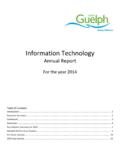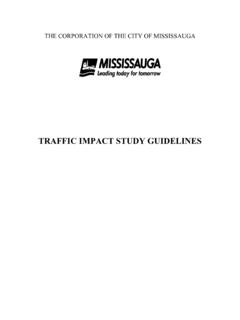Transcription of Traffic Impact Study Guidelines City of Guelph
1 Traffic Impact Study Guidelines Page 1 of 14 Traffic Impact Study Guidelines city of Guelph April 2016 Engineering and Capital Infrastructure Services Infrastructure, Development & Enterprise 1 Carden Street Guelph , Ontario Canada N1H 3A1 Traffic Impact Study Guidelines Page 2 of 14 INTRODUCTION As a single-tire municipality, the city of Guelph has jurisdiction over the road system from arterial roads to minor local streets, and provides transit service through Guelph Transit. The city s road network also includes both Provincial and County of Wellington roads. The city s Official Plan, Transportation Master Plan and Transit Growth Strategy and Plan provide a general outline of desired development patterns and the anticipated evolution of the general road network.
2 As specifics of a development are known, it is necessary to examine its impacts on the transportation system. In most cases, the onus is on the developer to conduct a Transportation Impact Study (ITS) to address the transportation-related issues of the development and obtain approval of the Study . GENERAL REQUIREMENTS Traffic Impact Study The purpose of a Traffic Impact Study is to identify the need for modifications to the city s transportation system regarding a new development/redevelopment by estimating the travel demands related to the development and assessing the impacts that the development would have on the present and future transportation system. Transportation Demand Management (TDM), transit and non-motorized modes will all be taken into account in estimating travel demand.
3 The purpose of following Guidelines is to ensure that a Traffic Impact Study meets the following criteria: Objective assessment the Study will evaluate the impacts of proposed development in a rational manner; Consistency the Study will utilize assumptions consistent with the city s accepted methodologies and parameters and thus be comparable to other Traffic studies in the city ; Recognized by developers and consultants the Guidelines will provide a standard approach to be followed and will reduce confusion and delay in processing development proposals; Promote understanding of process the steps outlined in these Guidelines will enable proponents/consultants, reviewers and elected officials to understand the process more effectively; and Traffic Impact Study Guidelines Page 3 of 14 Ease of review by staff a standardized set of Guidelines will aid the efficiency of staff in reviewing.
4 Need for a Traffic Impact Study In general, a Traffic Impact Study is submitted in support of any proposed development which is expected to generate a total of at least additional (new) 100 vehicle trips (inbound and outbound) during the adjacent roadways peak hour or the development s peak hour. A Traffic Impact Study may also be required even if there are less than 100 additional vehicles during peak hours when one or more of the following conditions are anticipated or present: The development is located in an area of high roadway congestion and/or a high expected rate of population or employment growth; The access or type of operation of the development is not envisaged by local land use or transportation plans; As part of the proposed development, a new Traffic signal or a roundabout is proposed; Existing transportation problems in the local area, such as a high crash location, complex intersection geometrics, heavy Traffic corridors.
5 The development has the potential to create unacceptable adverse operational and safety impacts on the local road network such as, o Inadequate horizontal or vertical sight distance at access points; o The proximity of the proposed access points to other existing driveways or intersections; o Lack of existing left or right turn lane(s) on the adjacent roadway at the proposed access points; and o The vehicular Traffic generated by the development would result in volume/capacity (v/c) ratios at a signalized intersection becoming critical ( greater than overall or for a shared through/turning movement, or greater than for an exclusive turning movement.) Staff Consultant and Preliminary Investigation Before commencing a Traffic Impact Study for a particular site, developers or their consultants are advised to discuss with city staff in order to review the level of detail, verify the Study scope and Study area, determine data requirements, and to confirm assumptions used in the analysis.
6 The Traffic Impact Study should take into account the findings of previous studies and transportation system concerns pertaining to the Study area. The Study should also Traffic Impact Study Guidelines Page 4 of 14 consider adjacent sites with the potential for developments within the same time horizon as the subject site, wherever possible through a joint Traffic Impact Study for the group sites. Traffic Impact Study OUTLINE The Traffic Impact Study should contain the sections outlined below. Description of the Proposed Development The Traffic Impact Study should provide a full description of the project. This includes but not limited to the following elements, Municipal address; Existing land uses or permitted use provisions in an Official Plan, Official Plan Amendments, Zoning By-law etc.
7 ; Proposed land uses and relevant planning regulations to be used in the Study ; Total building size and building location; Floor space including a summary of each type of use/number of residential units; Anticipated date of occupancy; Approximately hours of operations; Planned phasing of the developments; The location of access points and type of access (full turn, right-in-right-out, turning movement restrictions, etc.); Surrounding road networks, intersections and type of controls; Transit stops and services; Bicycle and pedestrian links and facilities; Nearby curb parking and off-street parking; Nearby developments and their access points; and Proposed internal parking arrangement and circulations. A site plan of a suitable scale should be provided for consideration in the review of the Traffic Impact Study .
8 Study Area The Study area should extend far enough from the development to contain all city roadways that will be noticeably affected by the site Traffic . Typically this will include the area that may be impacted as follows, Traffic Impact Study Guidelines Page 5 of 14 An increase of 5% or more Traffic volumes on adjacent facilities; Volume/capacity (v/c) ratios for overall intersection operations, through movements or shared through/turning movements increased to or greater; or V/c ratios for exclusive turning movements increase to or greater. The city reserves the right to establish the Study area as may be deemed necessary. It is recommended to consult with city staff prior to initiating the Study . The Traffic Impact Study should contain a map that identifies relevant information such the following, All adjacent roads including the road classifications, number of lanes, on-street bike lanes and posted speeds; All adjacent and affected intersections including type of control, lane configurations, lane widths, and any turning or similar restrictions; If appropriate, on-street parking spaces, stopping restrictions, and parking meters in the vicinity of the development site and those which would affect the operation of key intersections being analyzed; Transit routes, stops and terminals; Heavy vehicle prohibitions and restrictions; and Other transportation facilities such as trails and walkways, etc.
9 Potential future transportation improvements that are currently being considered and may facilitate the Traffic demand produced by the development/redevelopment should be identified. These improvements should be described to a level of detail sufficient to assess their implications for travel to/from the development. In each case, identify the status and anticipated date of implementation. Horizon Years and Peak Periods Horizon Years Identify horizon years for the analysis, which will be, The year of completion of the development; Five (5) years after the completion of the development; If the development is to be carried out in phases, Impact analysis for each phase should be undertaken; and Additional horizon years that may be required depending on the magnitude of the development, any major transportation system changes, or other planned significant land use changes.
10 Traffic Impact Study Guidelines Page 6 of 14 Peak Periods The critical time period is directly associated with the peaking characteristics of both the development related Traffic and the nearby transportation system Traffic . Typically the AM and PM peak Traffic period will constitute the worst scenario combination of site related and background Traffic . However in the case of retail, entertainment, religious, institutional, sport facility uses, the Saturday, Sunday or site peak may require analysis. As part of the consultation process prior to the commencing the Study , the consultant should determine in conjunction with the city for the selected time for the Study . Existing Traffic Conditions The Traffic Impact Study should provide exhibits showing the existing Traffic volumes and turning movements for roadways and intersections in the Study area including pedestrian and cyclist volumes, and heavy truck movements.















